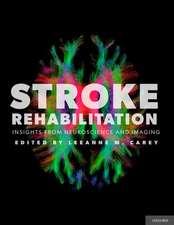Catecholamines and Behavior · 1: Basic Neurobiology
Autor Arnold J. Friedhoffen Limba Engleză Paperback – 19 mar 2012
Preț: 366.56 lei
Preț vechi: 385.84 lei
-5% Nou
Puncte Express: 550
Preț estimativ în valută:
70.15€ • 72.82$ • 58.49£
70.15€ • 72.82$ • 58.49£
Carte tipărită la comandă
Livrare economică 22 martie-05 aprilie
Preluare comenzi: 021 569.72.76
Specificații
ISBN-13: 9781468431377
ISBN-10: 1468431374
Pagini: 256
Ilustrații: XVI, 236 p. 9 illus.
Dimensiuni: 155 x 235 x 13 mm
Greutate: 0.36 kg
Ediția:Softcover reprint of the original 1st ed. 1975
Editura: Springer Us
Colecția Springer
Locul publicării:New York, NY, United States
ISBN-10: 1468431374
Pagini: 256
Ilustrații: XVI, 236 p. 9 illus.
Dimensiuni: 155 x 235 x 13 mm
Greutate: 0.36 kg
Ediția:Softcover reprint of the original 1st ed. 1975
Editura: Springer Us
Colecția Springer
Locul publicării:New York, NY, United States
Public țintă
ResearchCuprins
1 Function of the Central Catecholaminergic Neuron: Synthesis, Release, and Inactivation of Transmitter.- 1. Introduction.- 2. Analytical Methods.- 3. The Distribution of the Catecholamines.- 4. Storage.- 5. Biosynthesis of Catecholamines.- 6. Regulation of the Biosynthesis.- 7. The Metabolic Inactivation of Catecholamines.- 8. Turnover of Catecholamines.- 9. The Release of Noradrenaline.- 10. Some Aspects of the Pharmacology of Brain Catecholamines.- 11. Conclusions.- 12. References.- 2 Catecholamines in Regulation of Motor Function.- 1. Introduction.- 2. Clinical Evidence for the Involvement of Catecholamines in the Control of Movement.- 3. Animal Models for the Study of Catecholamines and Motor Function.- 4. Conclusion.- 5. References.- 3 Catecholamines in Behavior and Sensorimotor Integration: The Neostriatal System.- 1. Introduction.- 2. Clinical Considerations.- 3. Behavioral Observations.- 4. Anatomical Studies.- 5. Functional Aspects.- 6. Conclusion.- 7. References.- 4 Catecholamines in Activation, Stereotypy, and Level of Mood.- 1. Introduction.- 2. Behavioral Activation and Stereotypy Induced by Amphetamines in Animals.- 3. Possible Role of Noradrenaline in Behavioral Activation and Stereotypy Induced by Morphine.- 4. Effects of Amphetamines and Neuroleptics on Activation, Stereotypy, and Mood in Humans.- 5. References.- 5 Functional Interrelationships of Principal Catecholaminergic Centers in the Brain.- 1. The Role of Biogenic Amines in the Mediation of Certain Central Nervous System Functions.- 2. Results of the Studies.- 3. Discussion.- 4. References.- 6 Tremography as a Measure of Extrapyramidal Function in Study of the Dopamine Hypothesis.- 1. Abnormal Movements in Schizophrenia.- 2. Neuroleptic Action of Antischizophrenic Drugs.- 3. Relation Between Neuroleptic and Therapeutic Actions.- 4. Tremography as a Measure of Extrapyramidal Function.- 5. Study of Neuroleptic and Therapeutic Effects.- 6. Evidence from Psychotoxic Effects.- 7. Study of Amphetamine Model Psychosis.- 8. Cardiovascular Effects of Amphetamine Isomers.- 9. The Usefulness of Tremography.- 10. Summary.- 11. References.- 7 Mammalian Biosynthesis of Potential Psychotogens Derived from Dopamine.- 1. Introduction.- 2. Behavioral and Biochemical Effects of 3,4-Dimethoxyphenethylamine.- 3. The Methylation Hypothesis.- 4. Some Aspects of Biological O-Methylation.- 5. Conclusions.- 6. References.- 8 Regulation of Brain Dopamine Turnover Rate: Pharmacological Implications.- 1. Introduction.- 2. Problems in Interpreting the Compartmentation and the Functional Implications of Turnover Rate Measurement of Neuronal Dopamine.- 3. Molecular Mechanisms for the Regulation of Dopaminergic Neurons.- 4. Interaction of the Nigrostriatal Dopaminergic System with Other Neuronal Systems.- 5. Conclusions.- 6. References.









